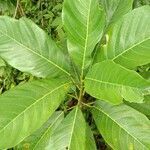Trees, 25-35 m tall, trunk straight, d.b.h. 25-35 cm. Bark gray to pale gray, hard. Branchlets wrinkled when dry. Stipules ovate-lanceolate, 1-1.8 cm, pubescent. Petiole 3-9 cm; leaf blade broadly elliptic, 15-30 × 8-20 cm, leathery, abaxially pale green but grayish green when dry, adaxially green, glabrous, and shiny, base rounded to broadly cuneate, margin entire, apex obtuse or mucronate; secondary veins 8-11 on each side of midvein, prominent on both surfaces. Figs axillary on normal leafy stem, paired or solitary, yellow when mature, pear-shaped-ellipsoid, 1.2-2.5 × 1-1.5 cm, pubescent but glabrescent, base attenuate into a 1 cm stalk, apical pore flat; peduncle 1-1.2 cm; involucral bracts lanceolate-ovate, ca. 2 mm. Male, gall, and female flowers within same fig. Male flowers: near apical pore or scattered, thickly pedicellate; calyx lobes 3-5, spatulate; stamen 1 or 2; filaments thin, if stamen 1 then filament absent. Gall flowers: similar to female flowers but stigma very short. Female flowers: calyx deeply 3-5-lobed, broadly lanceolate; style lateral; stigma deeply 2-branched. Achenes obovoid. Fl. Sep-Oct.
A fig. It is a large tree. It grows 25-35 m tall. The trunk is 25-35 cm across. The bark is hard and grey. The leafy growths at the base of the leaves are oval, hairy and 1-1.8 cm long. The leaf stalk is 3-9 cm long. The leaves are a dark green and smooth and shiny on the top surface. They are pale green underneath. They have a blunt point and are rounded at the base. The leaves are 15-30 cm long by 7-20 cm wide. They are leathery. The fruit are borne in the upper leaf axils. They are often in pairs. They are 2 to 3 cm across. They are pale green but become yellow when mature.






